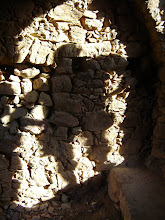A few days ago, I was driving along Woldgate in the East Riding of Yorkshire, in countryside not dissimilar to South Limburg, after spending a terrific afternoon at Flamborough Head. This C-classified road is as straight as an arrow and is marked on the Ordnance Survey map as a Roman Road, which supposedly linked York with the coast from where I'd just come. There are 'gates' aplenty in the North-East of England, most notably in York (Stonegate, Goodramgate and Skeldergate). These 'gates' have nothing to do with the gateways that are dotted around the ancient city walls of York, which are known locally as bars (Bootham Bar, Monk Bar). The names of these streets originate from the Viking word 'gata', meaning 'road' or 'way'. Presumably, the name Woldgate is derived from the same origin.
We know that much of the region was under Viking domination prior to 950, where Danish law and custom were observed, hence the name Danelaw to denote the territory that split England in two along a line from the Dee to the Thames. To the south-west of the line, Anglo-Saxon law held sway.
The Vikings first invaded England in around 800 and over the next 50 years or so seized large amounts of territory in Northern England including the Northumbrian (Anglo-Saxon) capital of Eoforwik, which was renamed Jorvik (now York). Viking settlements were established in the fertile regions in the North and East Anglia (alongside existing Anglo-Saxon ones). The Danes divided Yorkshire into three parts called 'Ridings' (Old Norse for 'third') for administrative purposes and these three regions were to survive for many centuries.
It was not far from here, at Stamford Bridge, that in 1066 the Vikings suffered their final defeat on English soil at the hands of King Harold, who himself lost a more famous battle two weeks later at Hastings.
The Yorkshire Wolds abounds with strange-sounding place names: Wetwang, Thwing, Langtoft, Kirkby Grindalythe, Weaverthorpe, Ruston Parva, Fangfoss and Nunburnholme to name but a few. The exact origins of these place names is uncertain, but what is for sure is that they include common Viking elements: Toft (a plot of land or farm), Thorpe (a small farm, hamlet of outlying settlement), By (a farm or village), Holm (water meadow) and Foss (a ditch). It is thought that 40 percent of place names in the East Riding of Yorkshire owe their existence to a Scandinavian presence, even though these settlements might have already been in existence during Saxon rule. And Viking and Saxon settlements would have coexisted with each other.
Some language historians have theorised that the mix of the two languages was responsible for kick-starting the 'simplification' of Old English into Middle English. Until the arrival of the Scandinavians, Old English was a strongly inflected tongue (like modern German) where common words relied on word-endings to convey a meaning for which we now use prepositions, like 'to', 'with' and 'from'. And, for example, by adding an -s, plurals were made less complicated. Only a few old noun inflections have survived, such as geese, mice and children. The complications of the language, it is said, were gradually ironed out as a way for Anglo-Saxon and Scandinavian speakers to understand each other better, through an ongoing process of 'pidginsation'. Of course, this shift didn't take place overnight, but over a period of centuries.
In addition to their place names, the Vikings donated many words to the English language (common words like get, hit, leg, low, root, skin, same, want and wrong are all of Scandinavian origin) and even more words survive in dialect. The word 'laik', for example, still enjoys popular use by children throughout the North-East and Cumbria, where it means 'to play'. A famous Danish product that many people will have played with in their childhood is Lego, which comes from the Danish 'leg godt' meaning to 'play well'.










